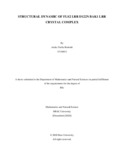| dc.contributor.advisor | Mubassir, M H M | |
| dc.contributor.author | Rodoshi, Anika Tasfia | |
| dc.date.accessioned | 2022-11-16T04:16:46Z | |
| dc.date.available | 2022-11-16T04:16:46Z | |
| dc.date.copyright | 2020 | |
| dc.date.issued | 2020-12 | |
| dc.identifier.other | ID: 15136013 | |
| dc.identifier.uri | http://hdl.handle.net/10361/17574 | |
| dc.description | This thesis is submitted in partial fulfillment of the requirements for the degree of Bachelor of Science in Biotechnology 2020. | en_US |
| dc.description | Catalogued from PDF version of thesis. | |
| dc.description | Includes bibliographical references (pages 27-30). | |
| dc.description.abstract | This study includes a protein subunit extraction from Arabidopsis Thaliana. Arabidopsis
Thaliana, an ideal plant for any type of research leading to a new direction of genetic
experiments. Its importance shows by its minimum size that restrict the need of growth facilities,
self-pollination that speeds the seed production. A mutation in the third leucine repeat of the
BRI1 linked kinase 1(BAK1) protein of 4mn8 in Arabidopsis Thaliana changes the 122nd amino
acid which is aspartate to asparagine along with deleted flg22.The mutation is specifically
associated with photo morphogenesis. The BAK1 enzyme, however, also plays a key role in
plant immunity by producing a heterodimer with a pattern-triggered flagellin sensing 2 (FLS2)
receptor, a bacterial flagellin elicitor protein that leads to BAK1 and FLS2 trans-phosphorylation
and subsequent initiation of the signal transduction pathway which is involve in activation of the
immune response. The impact of the D122N mutation in BAK1 on the structural integrity of the
FLS2-BAK1 complex was investigated here through molecular dynamics simulation. The
D122N mutation in the native FLS2-BAK1 crystallographic structure of the BAK1 protein was
induced using the in silico process. Simulation was done for both native and mutant complexes
by subsequently utilizing molecular dynamics techniques for 5ns.The mutant and native complex
is compared based on some parameters like RMSD (Root Mean Square Deviation), RMSF (Root
Mean Square Fluctuation), Rg (Radius of Gyration), Hydrogen bond etc. The mutation is found
to result in lower deviation of atoms from reference structure for the whole complex, FLS2-
BAK1, compared to counterpart from the non-mutated complex. RMSF analysis revealed that
mutation caused lower fluctuation of amino acid in both the N terminal and C terminal of FLS2-
BAK1 complex that hinder stable interactions.FLS2-BAK1 had a lower radius of gyration at the
complex containing mutation compared to the non-mutated complex. The mutation hindered the
viii
formation of hydrogen bonds among all the peptides, often terminating all the hydrogen bonds
between peptide. | en_US |
| dc.description.statementofresponsibility | Anika Tasfia Rodoshi | |
| dc.format.extent | 30 Pages | |
| dc.language.iso | en_US | en_US |
| dc.publisher | Brac University | en_US |
| dc.rights | Brac University theses are protected by copyright. They may be viewed from this source for any purpose, but reproduction or distribution in any format is prohibited without written permission. | |
| dc.subject | Protein Subunit | en_US |
| dc.subject | Arabidopsis Thaliana | en_US |
| dc.subject | BRI1 linked kinase 1(BAK1) protein | en_US |
| dc.subject | FLS2-BAK1 | en_US |
| dc.subject.lcsh | Arabidopsis thaliana | |
| dc.title | Structural Dynamic of FLS2 LRR D122N BAK1 LRR Crystal Complex | en_US |
| dc.type | Thesis | en_US |
| dc.contributor.department | Department of Mathematics and Natural Sciences, Brac University | |
| dc.description.degree | B. Biotechnology | |

